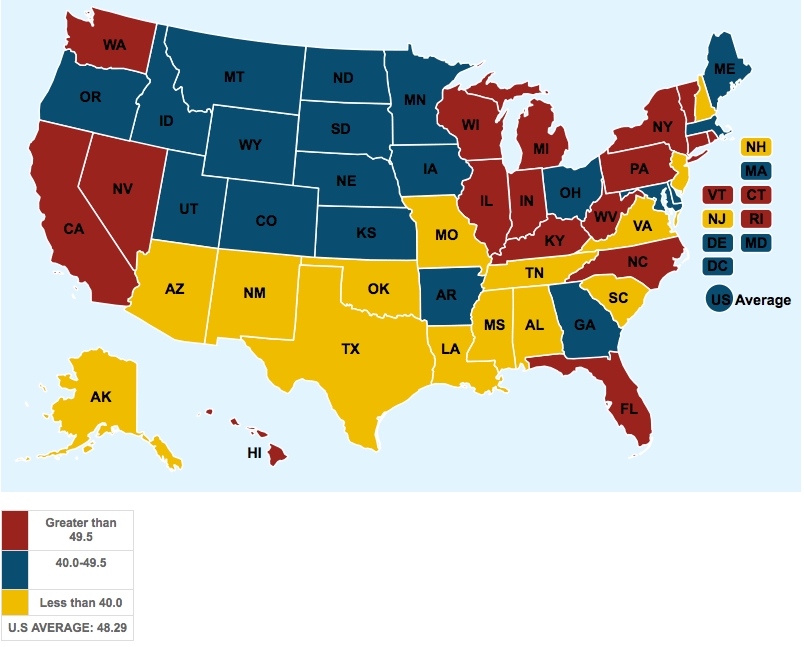It’s autumn, and like many citizens of North Carolina, my husband and I recently went to the mountains to view the splendor of the Appalachian leaf display. We purchased a bushel of North Carolina apples, ate at some of the local restaurants, and walked around the small towns in our state’s westernmost counties. At times we ventured outside of North Carolina and found a pleasant surprise: gas was below three dollars a gallon.
We started talking about gasoline prices and why they were so low in the neighboring states compared to North Carolina. Growing up in Gaston County, my friends and I always drove to South Carolina to fill up. So I was curious, has North Carolina made any attempts to lower the gasoline tax to be more competitive with neighboring states, and why has the gasoline tax increased so much from when I was a teen driver to today?
First, I looked at gasoline prices in neighboring states to see just how much higher ours was. I found that North Carolina’s gas tax has been consistently higher than neighboring states’, by more than twenty cents in some cases.

It is obvious North Carolina has a high state gasoline tax when compared to neighboring states. The federal gasoline tax of 18.4 cents per gallon has been constant since 1993, but states’ gas taxes have much more volatility and vary over a wide range. In fact, North Carolina is routinely ranked as one of the ten highest state gas taxes in the country, a list that includes New York, California, Illinois, and Hawaii.
To understand the changes in the tax rate, we should look to what the tax supports. It is the primary funding source for the NC Department of Transportation. The expected revenue to be collected from the motor fuels excise tax (including both gasoline and diesel) this year is around$1.8 billion. The revenue from the tax is then divided between the Highway Fund and the Highway Trust Fund, which receive 75 percent and 25 percent respectively. The largest expenditure from these funds is for road maintenance, bridge preservation, road construction, DMV administration, and debt service for transportation bonds.
The Department of Transportation is set up like an enterprise, a fund of self-balancing accounts that are segregated for specific purposes. Unfortunately, it hasn’t always actually operated that way in North Carolina. A good example of this was when former Gov. Easley made unconstitutional transfers from the Highway Trust Fund during the mid-2000s to balance the state budget. It is hard for an enterprise fund to be self-sustaining if the revenue for the fund is being spent outside the enterprise.
The gasoline tax was set at one penny per gallon in 1921, the year it was established. In 1989, the tax hit twenty cents and stayed relatively flat until 2000. During the Easley and Perdue administrations gasoline prices rose from 24 cents to 39 cents due to a combination of legislative increases and an automatic adjustment based on the wholesale price. It took North Carolina eighty years to raise the tax twenty-one cents. In less than fourteen years it increased nearly another twenty cents.
So why are gasoline taxes so high? Sending money from the highway funds to other areas of state government has caused a lot of the problem. Another factor is using gasoline taxes to fund non-highway related areas. Intermodal Divisions include bicycle and pedestrian, public transportation, ferry operations, airport programs, and rail services, and accounted for more than $345 million in the most recent state budget. While these are all types of transportation, they should not be paid for with the highway motor fuel excise tax.
People that drive on the roads in North Carolina pay the excise tax as a user fee. Essentially, the more you drive, the more you pay in the tax. So that money should go directly into the maintenance and preservation of roads in the state — not to other areas of transportation or other areas of the state’s budget. While legislators have changed some items within the transportation budget in recent years, more changes need to be made so we can lower the state’s excise tax on gasoline. This needs to be a priority in the next legislative session.
* The figures used in the table are all rates from January 1st of each respective year, except 2014 where the figure is from October 1st. Data came from The Tax Foundation’s, ‘State Gasoline Tax Rates’ and from the American Petroleum Institute.
Click here for the Fiscal Update archive.
You can unsubscribe to this and all future e-mails from the John Locke Foundation by clicking the "Manage Subscriptions" button at the top of this newsletter.

